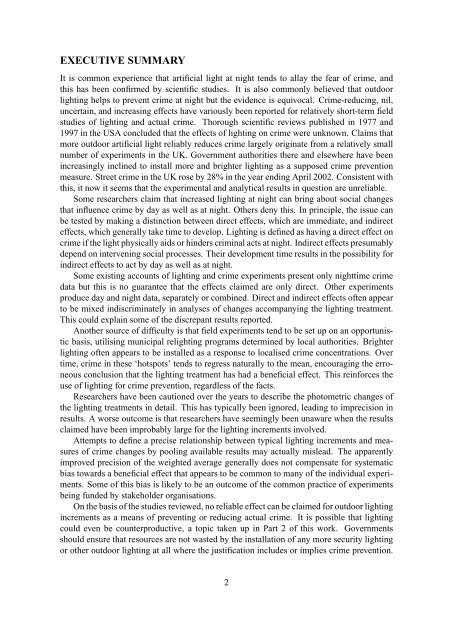outdoor lighting and crime, part 1 - Astronomical Society of Victoria
outdoor lighting and crime, part 1 - Astronomical Society of Victoria
outdoor lighting and crime, part 1 - Astronomical Society of Victoria
Create successful ePaper yourself
Turn your PDF publications into a flip-book with our unique Google optimized e-Paper software.
EXECUTIVE SUMMARY<br />
It is common experience that artificial light at night tends to allay the fear <strong>of</strong> <strong>crime</strong>, <strong>and</strong><br />
this has been confirmed by scientific studies. It is also commonly believed that <strong>outdoor</strong><br />
<strong>lighting</strong> helps to prevent <strong>crime</strong> at night but the evidence is equivocal. Crime-reducing, nil,<br />
uncertain, <strong>and</strong> increasing effects have variously been reported for relatively short-term field<br />
studies <strong>of</strong> <strong>lighting</strong> <strong>and</strong> actual <strong>crime</strong>. Thorough scientific reviews published in 1977 <strong>and</strong><br />
1997 in the USA concluded that the effects <strong>of</strong> <strong>lighting</strong> on <strong>crime</strong> were unknown. Claims that<br />
more <strong>outdoor</strong> artificial light reliably reduces <strong>crime</strong> largely originate from a relatively small<br />
number <strong>of</strong> experiments in the UK. Government authorities there <strong>and</strong> elsewhere have been<br />
increasingly inclined to install more <strong>and</strong> brighter <strong>lighting</strong> as a supposed <strong>crime</strong> prevention<br />
measure. Street <strong>crime</strong> in the UK rose by 28% in the year ending April 2002. Consistent with<br />
this, it now it seems that the experimental <strong>and</strong> analytical results in question are unreliable.<br />
Some researchers claim that increased <strong>lighting</strong> at night can bring about social changes<br />
that influence <strong>crime</strong> by day as well as at night. Others deny this. In principle, the issue can<br />
be tested by making a distinction between direct effects, which are immediate, <strong>and</strong> indirect<br />
effects, which generally take time to develop. Lighting is defined as having a direct effect on<br />
<strong>crime</strong> if the light physically aids or hinders criminal acts at night. Indirect effects presumably<br />
depend on intervening social processes. Their development time results in the possibility for<br />
indirect effects to act by day as well as at night.<br />
Some existing accounts <strong>of</strong> <strong>lighting</strong> <strong>and</strong> <strong>crime</strong> experiments present only nighttime <strong>crime</strong><br />
data but this is no guarantee that the effects claimed are only direct. Other experiments<br />
produce day <strong>and</strong> night data, separately or combined. Direct <strong>and</strong> indirect effects <strong>of</strong>ten appear<br />
to be mixed indiscriminately in analyses <strong>of</strong> changes accompanying the <strong>lighting</strong> treatment.<br />
This could explain some <strong>of</strong> the discrepant results reported.<br />
Another source <strong>of</strong> difficulty is that field experiments tend to be set up on an opportunistic<br />
basis, utilising municipal re<strong>lighting</strong> programs determined by local authorities. Brighter<br />
<strong>lighting</strong> <strong>of</strong>ten appears to be installed as a response to localised <strong>crime</strong> concentrations. Over<br />
time, <strong>crime</strong> in these ‘hotspots’ tends to regress naturally to the mean, encouraging the erroneous<br />
conclusion that the <strong>lighting</strong> treatment has had a beneficial effect. This reinforces the<br />
use <strong>of</strong> <strong>lighting</strong> for <strong>crime</strong> prevention, regardless <strong>of</strong> the facts.<br />
Researchers have been cautioned over the years to describe the photometric changes <strong>of</strong><br />
the <strong>lighting</strong> treatments in detail. This has typically been ignored, leading to imprecision in<br />
results. A worse outcome is that researchers have seemingly been unaware when the results<br />
claimed have been improbably large for the <strong>lighting</strong> increments involved.<br />
Attempts to define a precise relationship between typical <strong>lighting</strong> increments <strong>and</strong> measures<br />
<strong>of</strong> <strong>crime</strong> changes by pooling available results may actually mislead. The apparently<br />
improved precision <strong>of</strong> the weighted average generally does not compensate for systematic<br />
bias towards a beneficial effect that appears to be common to many <strong>of</strong> the individual experiments.<br />
Some <strong>of</strong> this bias is likely to be an outcome <strong>of</strong> the common practice <strong>of</strong> experiments<br />
being funded by stakeholder organisations.<br />
On the basis <strong>of</strong> the studies reviewed, no reliable effect can be claimed for <strong>outdoor</strong> <strong>lighting</strong><br />
increments as a means <strong>of</strong> preventing or reducing actual <strong>crime</strong>. It is possible that <strong>lighting</strong><br />
could even be counterproductive, a topic taken up in Part 2 <strong>of</strong> this work. Governments<br />
should ensure that resources are not wasted by the installation <strong>of</strong> any more security <strong>lighting</strong><br />
or other <strong>outdoor</strong> <strong>lighting</strong> at all where the justification includes or implies <strong>crime</strong> prevention.<br />
2
















